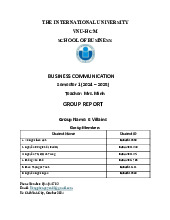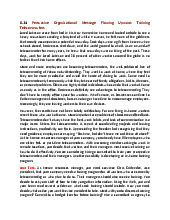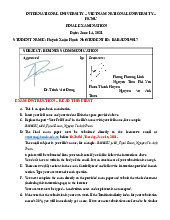









Preview text:
Vietnam National University – HCMC International University
SCHOOL OF BUSINESS ADMINISTRATION COURSE SYLLABUS1 BA006IU BUSINESS COMMUNICATION
Note: The outline with specific venue and time, and updated learning
materials for the current semester will be provided to the enrolled
students by the lecturer 1. COURSE STAFF
Lecturer: Phung Phuong Linh Teaching Assistant: TBA Room: A1-304 Telephone:
0989 344 767 (please DO NOT call after 7:00 pm) E-mail: pplinh@hcmiu.edu.vn Consultation Hours: By appointment only
The best way to contact me is by email. Please give me at least 24 hours to respond to your
email. Also, please feel free to make an appointment to see me during the semester. 2. COURSE INFORMATION
2.1 Teaching times and Locations Lecture: Phung Phuong Linh Venue: TBA 2.2 Units of Credit
This course is worth 3 credits.
2.3 Course prerequisite: N.A
3. COURSE AIMS AND OUTCOMES 3.1 AIMS
This course is emphasized on giving student a comprehensive view of communication in
business. The lessons are going to explore the impact of communication in today business,
beside, they show the role communication in establishing a favorable outside the firm
environment, as well as an effective internal communications program. During the course,
student will be covered different types of business communication media. More important, this
course will develop an awareness of how to write a succinct written message in modern business communication. 3.2 OUTCOMES
LO1. Identify the role and process of communication as a means of achieving organizational objectives.
LO2. Define communication and explain communication barriers.
LO3. Identify the different types of writing performed by business professionals in each of the
various functional areas of business.
LO4. Strengthen perception skills by embracing professionalism; by recognizing nonverbal
responses; by improving listening skill; and by analyzing personal value systems; role and
status, and cultural differences in organizational communication.
LO5. Apply a clear, concise, convincing, and correct style of writing for business purposes.
LO6. Complete an accurate, complete resume and cover letter.
LO7. Conduct well-prepared interviews and complete follow-up employment correspondence.
LO8. Demonstrate the ability to present effective oral reports. 4.0 Expectations
Attendance: University regulations indicate that if students are required to attend at
least 80 percent of class meeting (not more than classes absences) to be eligible to take the final
exam. Therefore, you might choose to use your absences for any reason, however, please
remember that the instructor reserves the right to fail students whose absences exceed more than 3 times.
Workload: It is expected that the students will spend at least six hours per week
studying this course. This time should be made up of reading, research, working on exercises
and problems, and attending classes. In periods where they need to complete assignments or
prepare for examinations, the workload may be greater. Over-commitment has been a cause of
failure for many students. They should take the required workload into account when planning
how to balance study with part-time jobs and other activities.
Student Responsibilities:
Student are expected to behave and to perform professionally while in class
Please be ON TIME. The class’s door will be clocked after 15 minutes. If you really
need to be late, please let me know in advance (with acceptable reasons).
There will be a break in every 45 minutes, therefore, DO NOT LEAVE in the middle
of the class meeting. If there is any special reasons, please ask for my permission.
NO TALKING, reading newspaper, playing games, completing homework, wearing
hats/caps, etc. are not allowed while in class
Do NOT disturb the instructor and classmates by using cell phones. Cell phones must
be put on the silent mode during class.
Participation is worth 5 percent of the total grade. Please contribute ideas and answer to questions raised
- Assignment Submission : Date of submission will be posted on the Blackboard site
and will also be informed in class. It is your responsibility to meet the deadline. Due
to the extremely high number of assignments, accepted NO late submission will be
(both home work and assignment)
All take-home assignments/projects must be typed.
Assignment should be submitted in both hard and soft copies
- The following format must be used for all ‘typed’ assignments and projects: • Times New Roman style; • 1.5 line spacing; • The font size of 12 cpi;
• A cover sheet (APA style) must be included in all assignments and projects.
Keeping informed The students should take note of all announcements made
in lectures or on the course’s Blackboard. From time to time, the university will
send important announcements to their university e-mail addresses without
providing a paper copy. The students will be deemed to have received this information.
5.0 LEARNING ASSESSMENT Assessment details Participation 10% Attendant 5% Mid-Term Exam 20%
In-class/Take-home assignments 5% Term Project 30% Final Exam 30%
________________________________________ Total 100%
Mid-term exam/Final exam (closed/opened book exam) Weight: 20% Duration: 90 minutes at least
Assessment format: Multiple choice questions, short essays and a business letter
Final exam (closed/opened book exam) Weight: 30%
Duration: 120 minutes at least
Assessment format: Short-essay questions and a business letter/report/job application package
Project Report (written assignment – 3000 words) Weight: 30%
Each team is required to choose one topic and complete the following topics:
Your team is required to conduct a business proposal. This business proposal should
represent your group ideas in starting a new business. Imaging that your team is
trying to attract investors. Therefore, please make sure you are able to convince them
to invest money after reading your proposal. - BOOK STORE - SOUVENIR SHOP - FOODS/DRINKS
Each team will have to do a presentation of the topic in class for maximum 10
minutes and to submit the written report (in both hard and electronic copies) to
lecturer on the day of presentation. One of the other groups in class will be
randomly chosen to be your group’s investors.
Marking criteria (project report and case presentation) Marking Criteria
Marks Learning outcomes/attributes Defining problem 20
Clear, concise statement of the problem.
Ability to structure problems in accordance
with theoretical frameworks to solve them.
Applying model 10 Ability to select or develop a suitable model. Ability to give
compelling arguments and reasoning to support analysis. Input data 10
Ability to conduct applied research to gather data/information. Ability to analyze the data
Developing a solution 20 Ability to get solution by using the computer and test the solution.
Analyzing the results, 10 Ability to analyze the results; to get the sensitivity analysis
solutions with small change in model or input data. Presentation of the result
30 Ability to present and give some
explanation of the result and withdraw a
lesson about the problem approach. Grading
The letter grade will be followed by the University suggested rule:
90-100: A+, 80-90: A, 70 – 80: B+, 65 – 70: B, 55 – 65: C+, 50 – 55: C, 30 - <50: D+, 10 - <30: D
5.6 Special Consideration
Request for special consideration (for final examination only) must be made to the Office of
Academic Affairs within one week after the examination. General policy and information on
special consideration can be found at the Office of Academic Affairs.
6. ACADEMIC HONESTY AND PLAGIARISM
Plagiarism is the presentation of the thoughts or work of another as one’s own (definition
proposed by the University of Newcastle). Students are also reminded that careful time
management is an important part of study and one of the identified causes of plagiarism is poor
time management. Students should allow sufficient time for research, drafting, and the proper
referencing of sources in preparing all assessment items. The university regards plagiarism as
a form of academic misconduct and has very strict rules regarding plagiarism.1
1 This is adapted with kind permission from the University of New South Wales. 7. STUDENT RESOURCES Textbook:
Mary Ellen Guffey, Essentials of Business Communicationt, 10th edition, Thompson South Western. Reference books:
Lesikar, R. V., & Flatley, M. E. (2008). Business communication: making connections in a
digital world (11th ed.). Boston: McGraw-Hill/Irwin.
Penrose, J. M., & Rasberry, R. W. (2004). Business communication for managers: an advanced
approach (5th ed.). Mason, OH: Thomson/South-Western.
Bienvenu, S., & Timm, P. R. (2002). Business communication: discovering strategy,
developing skills. Upper Saddle River, NJ: Prentice Hall. 8. COURSE SCHEDULE Week Content Activities 1 - Course introduction
- Activities 1: course introduction
- Unit 1: Business Communication in the
- Discussion 1: Skills needed in today Digital Age workplace
- Discussion 2: Inter-cultural communication 2
- Unit 5: Professionalism - Professionalism
- Discussion 2: Obstacles in
at work: business etiquette, ethics, communication teamworks
- Activity: team generation
- Activity: team introduction 3
- Unit 5: Business Presentation - Topic: TBA
Note: please have at least 02 laptops per team 4
- Unit 3: Positive Message
- Composing a Positive Message 5
- Unit 3 (cont): Negative Messages
- Composing a Negative Letter 6 - Unit 3 (cont):
Electronic Messages and Digital Media
- Discussion: Don’t Push That Send Button Persuasive Messages
- Composing a Persuasive Letter 7
1- RESERVED FOR THE GUEST SPEAKER
2- MIDTERM REVIEW 8
MIDTERM EXAM – GOOD LUCK ( TBA ) 10
- Unit 6: Employment Communication
- Discussion: What will make your job
application package stand out?
- In-class activity: Complete your Résumé (individual work)
- Team take-home assignment:
Completing Your Job Application Package (individual work) 11
- Unit 6 (cont): Employment
- Discussion: Is having a LinkedIn Communication account important?
- In-class activity: Completing your LinkedIn profile 12
- Unit 4: Business Research and Reports
- Discussion: Writing an Executive Summary That Means Business
- In-class Assignment: Composing an
Executive Summary; and a Letter of Transmittal 13
- Unit 4 (cont): Proposals, Business Plans,
- Discussion: Making your Proposal and Formal Reports Come Out on Top
- Extra Lecture 1: Dining Etiquette
- In-class Assignment: Completing the Formal Business Report
- Extra Lecture 2Non-verbal Communication 14 + 15 From 8.00 am
Final Project Presentation – 1.00 pm) 16
YOUR FINAL PROJECT DUE (The written version) TBA
FINAL EXAM – GOOD LUCK




